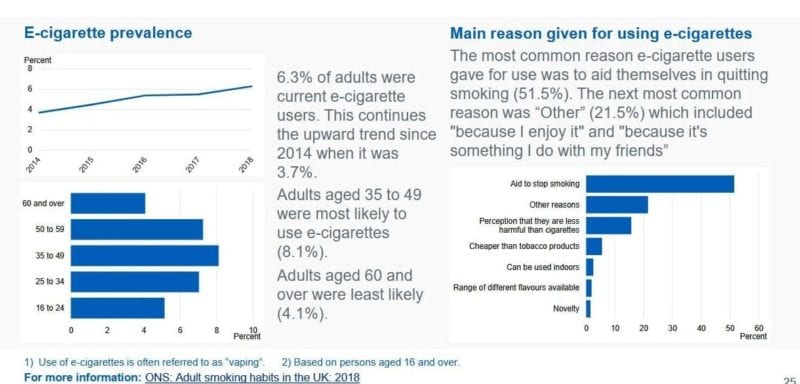Data released by the NHS shows a massive decline in the number of smokers in England and a continued rise in the number of vapers.
The Statistics on Smoking England: 2019 also shows that whilst there’s a slight rise in the number of young people trying an e-cigarette once, they too are saying no to lit cigarettes in their droves.
The annual study is prepared by the National Statistics Office and sadly despite the fall in smoking numbers, deaths from tobacco-related diseases still represent 20% of all male deaths and 12% of all female deaths – shocking, to say the least.

There’s a large drop in the number of prescriptions for ‘stop smoking’ drugs too – with just 396,000 written compared to 463,000 in 2017/18. This means a staggering saving to the cash strapped NHS of 65% which in real terms means in 2010/11 the cost was £65.9 million and this year it’s just £23 million.
You can’t help but think that massive fall is down to smokers getting more educated about the side effects these stop smoking drugs have and turning to e-cigarettes which they fund themselves – yet another tick in the vote vaping box.
Plus as we well know, patches, gums and in many cases drugs simply don’t work anywhere near as well as a vape product when it comes to successful quit smoking attempts.
Those In Their Fifties More Likely To Vape!
The rise of adult use of e-cigarettes is significant too and nudging away from the plateau reported last year. England now has 6.3% of the population classed as vapers compared to just 3.4% three years ago.
Of those, the most common age group is 35 to 49-year-olds with my lot – the 50 to 59ers next – go grey vapers! Next is the 25 to 34-year-olds, whilst the youngsters between 16 and 24 are the least likely to vape.

And vaping is kind of winning over smokers looking at them from a healthier perspective too with 70% of those currently smoking believing e-cigs to be safer whilst 78% of ex-smokers and using an e-cigarette know they’re safer.
One thing missing from these stats is the non-smoking public’s perception of vaping – that’s an education battle that really needs to be won if vapers are to have legislation and vape bans removed.
Vaping NOT a Gateway For Kids To Try Smoking
Despite all those dire warnings that vaping leads kids into smoking, the numbers speak for themselves – vaping is NOT a gateway for youngsters to smoke.
First, let’s look at how many kids are currently classing themselves as smokers. Back in 2017, the UK Government’s Tobacco Control Plan wanted to see the number of kids smoking drop to 3% and to some extent this has been achieved with 2% of males and 3% of females aged 15 saying they are regular smokers.
Additionally, there is a continuing shift in young peoples’ attitudes towards smoking, with decreasing numbers thinking it’s OK to try smoking or to smoke once a week; suggesting #vaping is not renormalising smoking.https://t.co/cIfFFWTunO pic.twitter.com/hcYyrv5mjB
— Sarah Jackson (@DrSarahEJackson) July 2, 2019
Now let’s look at the number of kids saying they have EVER tried an e-cigarette. The ‘ever’ is important as this is classed as trying an e-cigarette just once.
Based on the stats it looks as if there’s been a rise with 25% of kids quizzed saying they have tried an e-cig once and there’s also a rise of current and regular e-cig use among teens with 6% of those surveyed classing themselves as vaping 2 – 3 or more times per week.
Shock horror you might think – however marry those figures next to the continued decline in smoking rates among younger users, and you’ll see that far from a vape turning a kid into a 40 a day roll-up smoker, it really doesn’t – the numbers don’t lie!
Let’s hope that shuts the door on the so-called ‘gateway effect’ once and for all…though one seriously doubts it.
The Independent British Vape Trade Association [IBVTA] summed it all up nicely with this tweet:
New @ONS figures released today :
➡ approx. 3.2 million vapers in Britain
➡ more than half say they are #vaping to #quitsmoking
➡ more men than women #vape
➡ use by never smokers remains extremely low
➡ #smoking rate in Britain is down 5% since 2011https://t.co/CZbdMjNTl5 pic.twitter.com/0JMC6gy6ov— IBVTA (@TheIBVTA) July 2, 2019
You can read the full report HERE.





